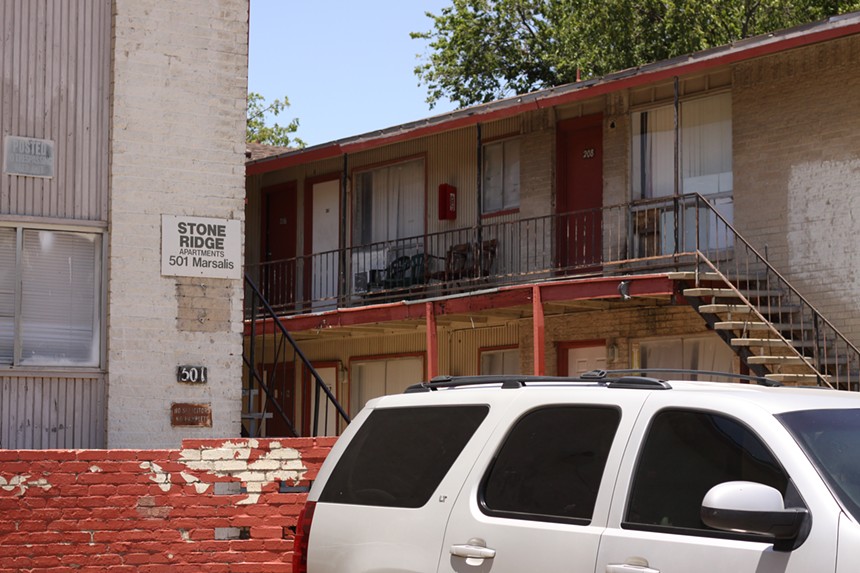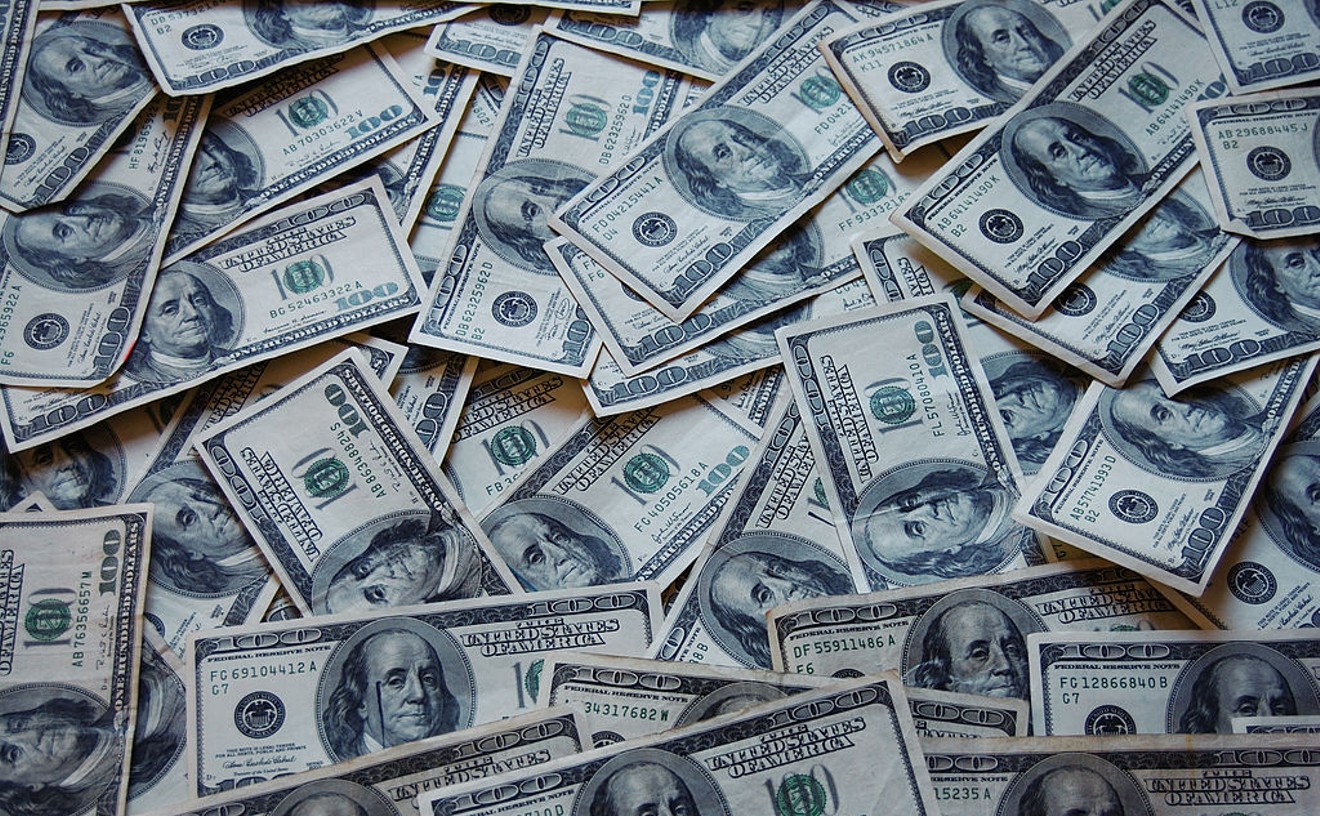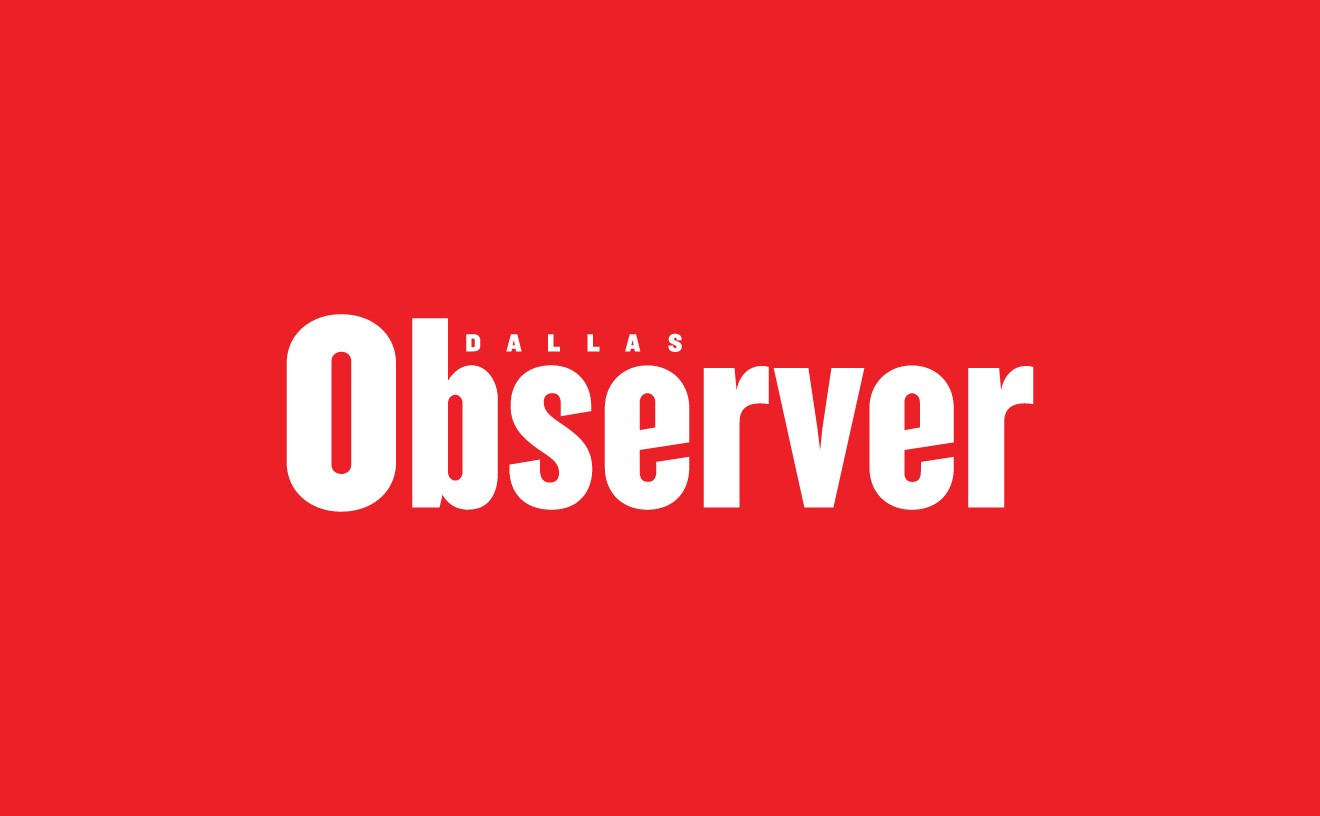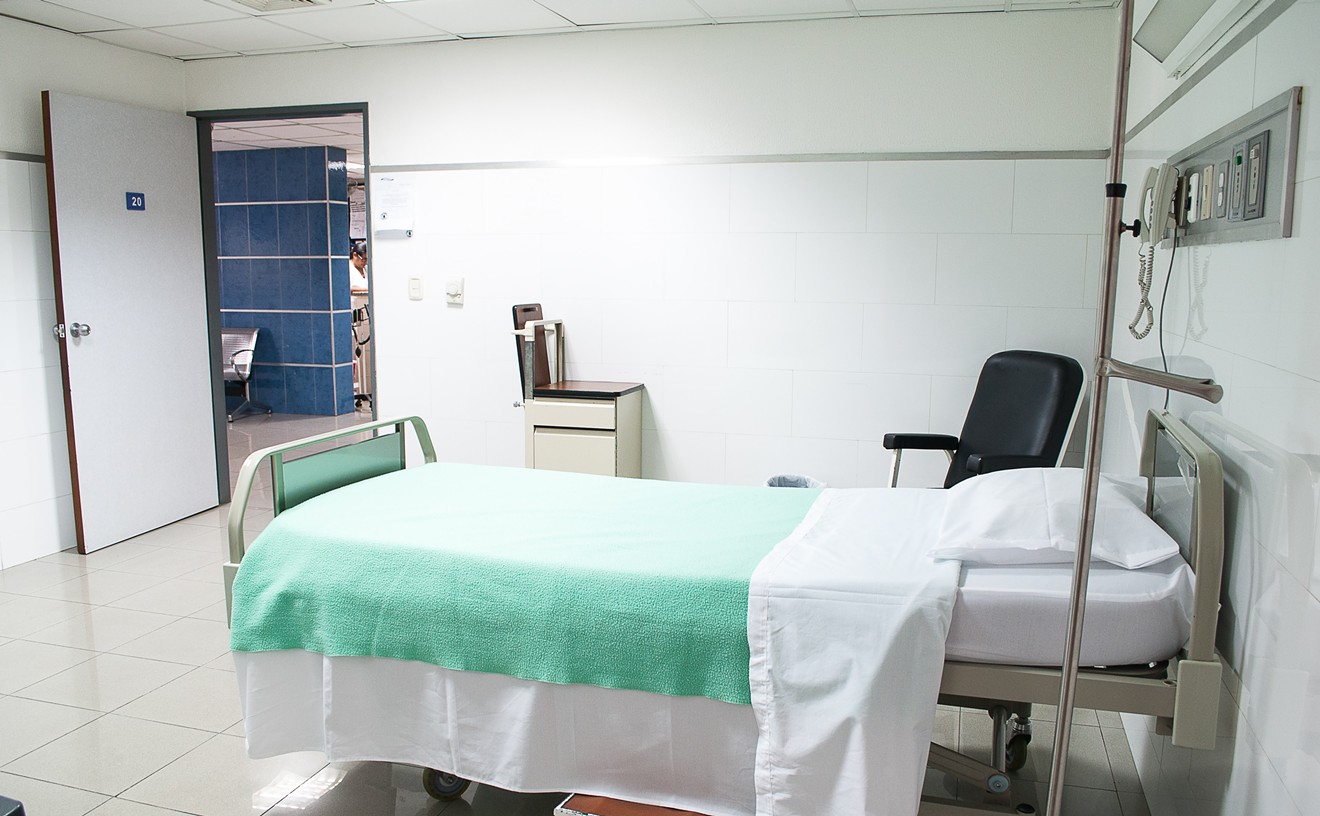Most of the complex’s units had boarded-up windows, ready for renovations and a rent increase. Hernandez and others couldn’t afford the higher rents and likely wouldn’t have met the new management company’s requirements.
Hernandez is blind and scrapes by on Social Security Disability Insurance (SSDI) payments. Most of that money would go toward his rent. The rest was just enough for groceries and a few incidentals. His mom would visit him every month to drop off his rent check. One day she showed up and found a note posted to his door that said the apartment was coming under new management. Rents would go up, the note said, but Hernandez was free to reapply if he wanted to stay.
“I need to find somewhere to go. I can’t afford that,” Hernandez said. A group called Fighting Homelessness was helping Hernandez and the others get better conditions at the apartment complex, pushing for repairs to gas leaks and action on stopping a rat infestation.
But since the notice about new management arrived, the group has been trying to find new homes for the residents priced out of the Oakridge Apartments.
They haven’t had any luck yet. Barring any rental assistance, which they’re working to get, there’s nothing in the tenants’ price range. Hernandez, for example, is used to spending between $600 and $700 on rent, most of his income. Finding something in that price range in a market as hot as Dallas is not easy. Some might say it’s impossible.
“That’s the reality out there,” Lisa Marshall, the homelessness advocate who started the Fighting Homelessness group, said. “People that are on fixed incomes, whether it’s [Social Security Disability Insurance] because of their disability or they’re elderly, or they’re on [Supplemental Security Income], there are no places out there to get and rent that are $650. Anything below that, you probably are renting from a halfway house or a drug rehab place or you’re just sharing a room with somebody in a boarding home. And they are few and far between. So, that’s the population that nobody thought about when all this rent was going up.”
According to apartmentlist.com’s October 2022 national rent report, rents nationwide are up by nearly 7% over last year's. In Dallas, rents have increased by a little over 12%. The average two-bedroom apartment in Dallas now costs about $1,500 a month."I need to find somewhere to go. I can’t afford that." - Hector Hernandez, renter
tweet this
Housing production in Dallas picked up between 2020 and 2021. At the beginning of 2020, builders had started on some 12,000 houses, according to the housing research firm Zonda. When 2021 rolled around, builders had started on more than 54,000. Despite this uptick, a report released this year by the national housing advocacy group Up For Growth found that another 3.8 million homes must be built in the U.S. to fill the country’s housing needs. That translates to about 322,000 homes across Texas and 85,220 across DFW.
Even as the housing market cools down – tracking with the first small month-to-month decrease in rent prices this year – it’s hard to see an end in sight to sky-high rents and mortgage rates.
People attribute the rising costs to factors like inflation, issues in the supply chain, short-term rentals and institutional investors. All of these things can contribute to the underlying issue — a massive housing shortage.
The production of new homes over the last 10 years simply hasn’t kept up with demand in the U.S. Changes in the industry in this period, such as the start of short-term rental companies like Airbnb and institutional investors’ expansion into the housing market, have also taken properties off the market for would-be homeowners.
***
Short-term rentals have stirred up a controversy in Dallas, as in other cities, especially from residents complaining that the rentals are being used as party and event spaces, creating a nuisance.
City officials and staff are still meeting to discuss how to deal with the short-term rental market in Dallas. Some have proposed using the city’s zoning laws to restrict rental locations, while others think they should be allowed in their current locations under tougher regulations.
There are about 1,200 short-term rentals registered in the city, but active listings suggest that there are many more in Dallas. As of Sept. 28, Dallas actually had 5,677 active properties, according to the website airdna.co, which provides information on short-term rentals. Most of those are listed on Airbnb.
Short-term rentals have the potential to benefit cities and neighborhoods. They could lead to an increase in tourism and stimulate the local economy. Property owners can benefit by turning their homes into another source of income. Tourists can enjoy lower travel costs by using short-term rentals.
But after a while, the negative effects of short-term rentals can start to outweigh the benefits.
A report by the Economic Policy Institute from 2019 looked into the economic costs and benefits of the short-term rental company Airbnb.
“While the introduction and expansion of Airbnb into U.S. cities and cities around the world carries large potential economic benefits and costs, the costs to renters and local jurisdictions likely exceed the benefits to travelers and property owners,” the report said.
“There is evidence that Airbnb increases the supply of short-term travel accommodations and slightly lowers prices,” the report said. “But there is little evidence that the high price of travel accommodations is a pressing economic problem in the United States: The price of travel accommodations in the U.S. has not risen particularly fast in recent years, nor are travel costs a significant share of American family budgets.”"That’s the reality out there." - Lisa Marshall, Fighting Homelessness
tweet this
Housing costs are a significant share of American family budgets, and they have seen huge increases in recent years for both renters and homeowners. There’s some evidence to suggest that short-term rentals are contributing to the problem.
The report says that one of the largest and best-documented potential costs of Airbnb’s expansion over the years is the reduction it causes in the housing supply.
Because the cost of housing doesn’t affect people’s need for it, the report says, “even small changes in housing supply (like those caused by converting long-term rental properties to Airbnb units) can cause significant price increases.”
The report says studies have indicated that Airbnb’s introduction and expansion into New York City, for example, may have raised average rents by nearly $400 annually.
***

Neighboring apartment complex is also showing wear. If residents can't afford these apartments, where can they go?
Jacob Vaughn
The Congressional Subcommittee on Oversight and Investigations has been looking into the influx of investor home-buying and its effects on the market.
The 2008 recession and its mass foreclosures put a huge number of homes on the market that many individuals couldn’t afford. That’s when corporations began gobbling up single-family homes across the country, a report by the subcommittee explained.
No single investor owned more than 1,000 homes in 2011. That has changed drastically over the last decade, with investors making more than half of 2021 home purchases in Tarrant County. In Dallas County, institutional investors accounted for 43% of 2021 home purchases.
Democrats and Republicans on the subcommittee seemed divided on the topic.
U.S. Rep. Tom Emmer, a Minnesota Republican and a ranking member of the subcommittee, pointed out during a June hearing that while investors may be increasingly buying up these properties, they still account for only a small portion of the country’s single-family rentals. According to the real estate consulting firm RCLCO, 2% of the 15 million single-family rental homes across the U.S. are owned by investors.
Emmer said investors are actually benefiting people by providing homes for rent that they otherwise wouldn’t be able to afford because of poor housing policy decisions and rising inflation, both of which he blames Democrats for.
“While many Americans can’t afford a full tank of gas or to buy meat at the grocery store, our subcommittee is focusing on institutional homeownership in the home rental market,” Emmer said. “We cannot demonize institutions for facilitating this supply of quality housing that otherwise would be out of the realm of possibility for many Americans due to the economic consequences of inflation.”
On the opposite side of the political spectrum, Chairwoman Maxine Waters, a Democrat from California, said these investors are going into communities and buying up homes that would be available to individuals had financial institutions given them the loans they needed to become homeowners. The problem has worsened throughout the pandemic.
“Institutional landlords have seized the COVID-19 pandemic as an opportunity to expand their reach even further into our homes,” Sofia Lopez, a deputy campaign director at the Action Center on Race and the Economy, told the committee. “Private equity’s business model hinges on boosting revenue, cutting costs, and maximizing efficiencies. … This is a recipe for disaster. In housing, it translates into exorbitant rent increases.”
Institutional investors are also some of the quickest to evict, the committee’s experts testified, and they often target moderate income Black and Hispanic neighborhoods. Missouri Rep. Emanuel Cleaver calls this “coup capitalism.”
“When I talk about ‘coup capitalism,’ it’s a coup d'etat because there’s an overthrow of the homeownership in the urban core and there’s a regime change that comes in,” Cleaver said. In Kansas City, Missouri, he explained, the west side is historically Hispanic and the east side is historically Black. These are the areas investors have targeted. “I began to call it ‘coup capitalism’ because the people have been overthrown. They’re leaving,” he said. “The west side is probably already lost.”"We cannot demonize institutions for facilitating this supply of quality housing that otherwise would be out of the realm of possibility for many Americans due to the economic consequences of inflation." - U.S. Rep. Tom Emmer
tweet this
You can see this on the ground in Dallas’ Elm Thicket-Northpark, a historically Black neighborhood where investors are buying up properties and driving up costs. Just east of Love Field, this neighborhood used to consist primarily of working class Black families living in single-family homes. Over the years, the Hispanic population has grown. The number of investor owned properties there has increased too.
Many of those homes have been bought and refurbished to the point of being unaffordable for lower-income renters. Others have been torn down and replaced by duplexes. Those duplexes tower over the original single family homes that remain. Some residents in them say they feel suffocated and like it’s only a matter of time before they’re priced out of the neighborhood. Others say they’re happy with what the new development has done and will do for property values
Investors also buying up apartment buildings like the one Hector Hernandez was staying in.
Jenny Schuetz, a senior fellow at Brookings Metro, told the congressional subcommittee in June, “We've been talking today about the single-family rental market, but we also know that institutional investors are buying multifamily rental buildings that are older, often doing a rehab, and then raising the rents on them.”
But Veena Jetti, a local real estate investor, said there are good and bad apples in the industry. The good ones can have positive effects on communities.
She said the multimillion dollar firms buying cheaper homes and pricing out the middle class from homeownership are the bad apples. “Now, they can’t increase their net worth through their primary home anymore,” Jetti said of the homeowners cut out of the market. Her company doesn’t do that though, she said.
Companies like hers can create higher density housing and bring affordability to areas that aren’t affordable, Jetti said. “The revenue and the benefits of having investors that truly care about the communities can be a positive thing,” she said.
It’s her hope that the properties she’s invested in can be tenants’ “last stop before homeownership,” something she recognizes is becoming less prevalent.
Jetti comes from a real estate family, and she has about a decade of experience in the industry. Jetti founded her own real estate investment firm called Vive Funds. The company’s been focusing on Class B value, multi-family real estate.
In the run up to the pandemic, prices were rising in the real estate market. Jetti thought it would start to level out, but that never happened.
Then, the pandemic broke out, wreaking havoc on the economy and causing people to miss work and paychecks and eventually get evicted, even though there was a moratorium on evictions at the time.
Higher income tenants might be able to get by missing two or three paychecks, Jetti said, but that’s not the case for people making less.
“It became tougher to manage assets with lower-income tenant bases because what would happen is they would miss two weeks of work because they were in the quarantine protocol,” she said. “Lower income tenants, they just don’t have as much of a cushion for emergencies like this.”
So, Jetti’s company started looking at more stable assets with solid tenant bases. From an investment perspective, what really matters is your risk tolerance, she said.
Going into a lower-income tenant base, there will be tougher management problems, she said. “The other side of that coin is by taking on more risk, you need to have more potential reward,” Jetti said. “Our investors don’t have the appetite for that kind of risk.”"The revenue and the benefits of having investors that truly care about the communities can be a positive thing." - Veena Jetti, real estate investor
tweet this
Others do. “You’ll find investors on all areas of the spectrum,” she said.
They don’t mind maximum risk as long as it means maximum returns. Others want minimal risk for modest returns.
“What we’ve seen in DFW specifically is a massive increase in demand not just for single family homes but also for multi-family assets,” Jetti said. “COVID ramped up the market and made it incredibly competitive.”
But, she thinks things will start to cool off. They already have compared to a few months ago, she said.
“The market goes in cycles. We have our bull runs and we have our bear runs,” she said. “It was a buyers market on steroids,” Jetti said. “It was unlike anything I had ever seen before.”
All of this, some say, is just a symptom of the underlying problem, which is that housing demand over the last decade has far exceeded production.
Phil Crone, executive director of the Dallas Builders Association, said some positive change is happening that he’s cautiously optimistic about. “The last couple [years] during the pandemic period were crazy. Just, non-sustainable in terms of the amount of demand versus our ability to supply it,” Crone said. With the market slowing down, builders may be able to start catching up.”
Historically low mortgage rates and a shift to remote work during the pandemic sent a shockwave throughout the housing market. Some reports estimate U.S. home prices rose some 42% as a result. Between the start of the pandemic and the end of 2021, Texas home prices rose by 28%. But, the market has started to cool off. From April to June, home sales in Texas dropped more than 5% compared with last year, according to Texas Real Estate Research Center at Texas A&M University.
“My hope is with the change that we’re going through, that it’s going to be a much welcome return to normalcy,” Crone said. There are more homes under construction now than ever before, over 33,000 across DFW. However, the light he sees at the end of this tunnel isn’t the brightest.
“I think a lot of builders are worried if the contracts [on the houses] are going to hold up and if those are going to get through to closing,” Crone said. “But, it is, finally … starting to create a little bit of beneficial impact to the record low inventory that we’ve had for new housing.”
Despite this, Crone said builders are wondering, “Are people still going to be able to afford the home that they thought they were going to be able to afford with the interest rates rising and being as changeable as they have been over the last few months?”
Crone said he doesn’t think it’s time for builders to worry. “For the last 10 years or more, we’ve not been able to produce enough housing to meet the demand of this market and we’re still quite a bit short,” Crone said. “We haven’t been able to keep up, and now that we’re having a little bit of time to catch up just a little bit, that’s not a time to worry. That’s a time to welcome the return to normalcy that, maybe, we’re seeing here, barring any massive spike in interest rates, which is still of course a possibility.”
Even without higher interest rates and with all the new construction, Crone said bringing new houses on the market is no easy task. For starters, Dallas’ permitting process became painfully slow during the pandemic, making it take even longer to get required building permits. The delays can also make the builds more expensive. Dallas has started to pick up the pace in issuing new permits, but Crone said the industry is running out of skilled workers, and some building materials are becoming increasingly hard to come by and pay for."We’ve had in our industry a labor shortage that significantly predates, by several years, the pandemic." - Phil Crone, Dallas Builders Association
tweet this
“We’ve had in our industry a labor shortage that significantly predates, by several years, the pandemic,” Crone said. “That’s just the product of an aging workforce that’s retiring, our country’s inability to have a coherent immigration policy to help with it and the inability, although it’s improving on this front a bit, to focus on training of the construction trades that’s needed to get the next generation of our workforce out there and being part of the industry.
“When you combine that with the fact that we’ve added a million people or more in the last decade, it creates that perfect storm.”
Then, there are supply chain issues.
According to 2021 U.S. Census data, the state’s population has grown by 650,000 in the last five years and that growth is expected to continue. With that being the case, Crone said, “I don’t see the situation or the fundamentals improving any. That’s why I’m hoping that, to the extent we can, we can keep building and get that supply out there because there will definitely be the demand for it.”
Crone said zoning reform is one of the biggest things that can be done locally to help speed the process along. “I think we have an obligation to look at, especially around here, the exclusionary history of zoning,” he said. “That history is still being written in many cities.”
The whole process could be a lot more straightforward, he said. “Most of the time, things have to be negotiated, many times to the nth degree, and that takes a lot of time,” he said. “That adds a lot of expense and there’s a better way to do it. I hope that Dallas and others will take the lead or even take the cue of other cities that have looked at this issue and applied it here because that sure would help.”
But, a speedier zoning process doesn’t mean squat when you don’t have the manpower or materials to build.
“I’m still hearing every day from builders who can’t find windows in a timely manner or doors, garage doors. It still feels like we’re playing Whac-A-Mole with whatever issues are happening in the supply chain,” he said. “It’s manifested with different products at different times, but collectively, it’s slowed down the homebuilding timeframe.”
It makes for a nerve racking experience for prospective homeowners.
“When you put yourself in the shoes of a prospective homeowner, you can’t get your mortgage or your permanent financing until very close to the time that the home is complete,” Crone said. “So, you’re sitting here riding the same rollercoaster as your builder trying to figure out when this can get done and hoping it’s going to happen before the next interest rate increase. That’s where there’s consternation on both sides of it, both with the builder trying to find these things and the homeowner hoping they do so they can lock in financing for what they can afford.”
Some, including builders, are flocking to the suburbs in search of affordability. It can be just as difficult to build in the suburbs, Crone said, but you can often get more bang for your buck. Sometimes, he said, the only way you can build affordably is when you’re building in the suburbs.
"For example, I never thought we were going to be looking at places like Terrell and Forney as quick as we were as growth areas,” Crone said. “But that’s a case just out of necessity because all of these other factors have made housing more expensive. The only thing we can control, especially in this area, is where we build those communities.”
Crone said he thinks some things will start to return to their pre-pandemic state, but the industry will still be left with the problems that have been brewing over the last decade and the uncertainties of today’s economy. Even after supply chain issues get resolved, and Crone thinks they will, the industry will still be suffering from a labor shortage.
However, as people try to build more affordable homes, they’re often up against people who don’t want to see that growth in their backyards.
“Another problem that’s kind of lurking on the horizon is just the anti growth attitudes that we see,” Crone said. “Those don’t fall on political lines. They’re just as common in progressive jurisdictions as they are in conservative ones, and that can be a real problem too.”
He said this comes up often in local zoning hearings with residents worried about how certain developments could affect their property values.
“That puts real pressure on local elected officials who realize that there’s a very low participation in these elections and that these growth issues can galvanize opposition against them,” Crone said. “Put it another way, I think a lot of people realize and understand. Maybe they have children or grandchildren that are struggling much more so to get a home than they did a few decades ago. So, they understand there’s a housing shortage and a housing crisis, but then if somebody wants to build a fourplex down the street, they’ll be the first ones to call their council members, go to the meetings and oppose that coming down the street.
“So, they’ll acknowledge the problem, but they don’t really want to help be part of the solution. We’re seeing that in the city of Dallas as much as we’re seeing it out in some of the more traditionally conservative suburbs both in this area and around the state.”
Whatever the cause, when home prices go up, they’re less attainable for more people, Crone said, and more attainable homes are what made Dallas what it is today. “That’s what our market has really been known for: being much more attainable than the place that people are here from. So, if we don’t think about it that way, we may see the end of our days as a leading market.”
While some may be able to pinch their pennies, cutting back on discretionary spending to accommodate for the increases in recent years, people on fixed incomes, like Hernandez, face a harsher reality. They never had much room for discretionary spending in their budget to begin with, so there isn’t a lot to cut out to make up the difference.
According to the National Council on Aging, an organization that advocates for people 65 and older, the average monthly benefit for SSI is $624 and $1,223 for SSDI as of January. The maximum amount you can get on SSI is between $841 and $1,261 depending on marital status and income. You can get as much as $3,345 on SSDI depending on your work history. Hernandez gets about a grand a month from SSDI.
Lisa Marshall, the advocate with Fighting Homelessness, said the Oakridge Apartment residents have had trouble finding new housing. Most options are out of their price range or too far away from family or service that help support them.
“Now, these tenants are scattered throughout the city, they’re probably in encampments or couch-surfing or whatever they’re doing. So, we just added to the total population of homelessness and we don’t have any solutions to remedy that.”














